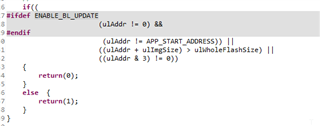Other Parts Discussed in Thread: HALCOGEN
Hello,
I successfully implemented a CAN Bootloader for our design which uses a TMS570LS0914; i was wondering how can we manage to update the Bootloader itself by means of an application which write the Bootloader memory to the new one.
Actually I just load the bin file in the C code as a "static const uint32_t newBootloader[] array ", and then I just run the following code.
uint8_t oReturnCheck = 0;
uint32_t size_of_bootloader = sizeof(TMS570LS0914PGE_CAN_Bootloader_SW);
uint32_t index = 0;
while(index<size_of_bootloader)
{
oReturnCheck = Fapi_BlockProgram(index, (uint32_t)&TMS570LS0914PGE_CAN_Bootloader_SW[index], 8);/**/
index = index+8;
}
however, this does not seems to work
Application code start at 0x40020, App_status_Address is 0x40000.
Is a smarter way to do it ?
THanks


